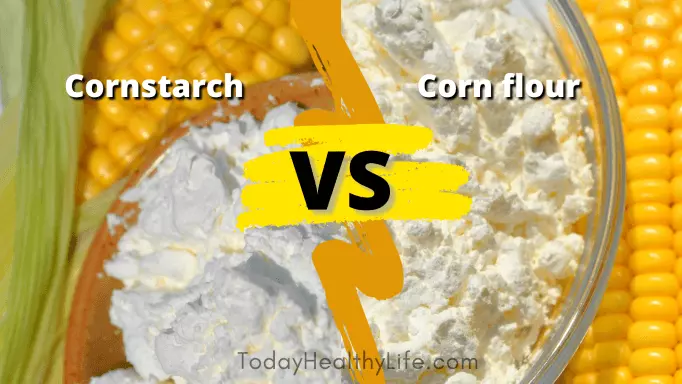With the ongoing cornstarch vs corn flour debates, anyone might feel curious about these two corn products.
As things get going, both are the ground powders of corn kernels. But, there still lies some differences between these two. Those are the characteristics that can easily help one to pick the best-suited carb for themselves between cornstarch and corn flour.
Here, we’ll provide you the structure comparison between cornstarch and corn flour- what they are, their calorie count, nutrition values, their use differences, and a comparative discussion on their health benefits as well as the probable health risks from both these.

Table of Contents
Cornstarch vs corn flour: what they are
Though both of these are made from corn and both are carb powders, their making processes and structures are different from each other.
The debate on cornstarch vs corn flour is fueled largely because of the ongoing gluten-free culture. Both of these have some unique concerns.
While corn flour is made by grinding the corn kernel only. Just taking the whole corn, washing them to remove the unnecessary parts and dust, drying them, and later grinding them to powder is all you’ll need to make corn flour.
In fact, corn flour can be homemade very often. And, there are two types of corn flour–
- White corn flour. You need to mill a finer grind to make white corn flour. And the prime difference between white and yellow corn flour lies in the milling process and color.
- Yellow corn flour. Less milling is enough to make yellow corn flour.
Both of these corn flours have similar structures. Though, white corn flour is better suited for thickening purposes, while yellow ones are better for sweet recipes.
On the contrary, you won’t be able to make cornstarch at home unless you have all the equipment necessary. That is because cornstarch needs to be more refined and protein-free.
While making cornstarch, you’ll need to carefully remove the protein from the kernel.
The differences are shown more specifically in the box below-
| Cornstarch | Corn flour |
| More refined. | Less refined. |
| Is only one type- white. | Two types- white and yellow. |
| Made by removing the protein. | Doesn’t remove the protein. |
| Can’t be homemade normally. | Can be homemade easily. |
So in short, they both are ground corns, but one is basic and the other one is more refined that’s it.
Also Read:
- What is corn starch: calories, nutrition, all uses, substitute idea.
- What is corn flour– nutrition, benefits, substitute, is it gluten-free?
- Why Do Females Eat Corn Starch? Does It Kill You?
- What Happens If You Eat Cornstarch Everyday? How To Stop It?
- What Does Eating Cornstarch Do To Your Teeth?
- What Does Eating Cornstarch Do To Your Body? – Risk & All.
Calorie count of cornstarch vs corn flour
As for carb-type ingredients, both cornstarch and corn flour have quite good quantities of calories. Though corn flour has slightly fewer calories than cornstarch because they have some proteins as well.
Every 100 grams of yellow corn flour contains 361 calories, and every 100 grams of white corn flour contains 363 calories. The difference between white and yellow corn flour is not that much, to be honest.
Moving to cornstarch, they are almost all carbs. That’s a reason why it has higher calories.
Every 100 grams of cornstarch contains 381 calories. The prime reason behind the higher amount of carbs in the cornstarch is, cornstarch is more refined to lose the proteins, hence they have the carb values rise.
You can see the difference on your own right?
Nutrition differences between corn flour vs cornstarch
Corn flour and cornstarch are both made from corn, but they have different nutritional profiles.
Corn flour is made by finely grinding whole corn kernels, whereas cornstarch is made just from the starchy part of corn.
As a result, corn flour contains protein, fiber, starch, vitamins, and minerals, whereas cornstarch is mostly carbs.
Here is a comparison of the nutrient contents of 1/4 cup (29 grams) of cornstarch and corn flour:
| Nutrient | Cornstarch | Corn Flour |
|---|---|---|
| Calories | 120 | 110 |
| Total Carbohydrates | 28 grams | 22 grams |
| Dietary Fiber | 0.3 grams | 1.5 grams |
| Protein | 0.2 grams | 3 grams |
| Fat | 0 grams | 0 grams |
| Magnesium | 13 mg | 29 mg |
| Iron | 0.3 mg | 1.2 mg |
| Potassium | 26 mg | 100 mg |
As you can see, corn flour is a better source of protein, fiber, magnesium, iron, and potassium than cornstarch. However, cornstarch has a slightly lower calorie content.
In general, corn flour is a healthier choice than cornstarch. It is a good source of nutrients and can be used in a variety of dishes.
Cornstarch is not as nutritious, but it can be useful as a thickening agent in sauces and gravies.
Uses of cornstarch and corn flour
Cornstarch and corn flour have various uses in cooking and baking. Here are the common applications for each:
Uses of Cornstarch:
- Thickening Agent: Cornstarch is primarily used as a thickening agent in sauces, soups, stews, and gravies. It has a high starch content and when mixed with liquid and heated, it forms a gel-like consistency, helping to thicken the mixture.
- Baking: Cornstarch is often used in baking to achieve a lighter and more tender texture in cakes, cookies, and other baked goods. It can be used as a partial substitute for all-purpose flour to produce a softer crumb.
- Coating and Frying: Cornstarch is commonly used as a coating for fried foods. It creates a crisp and golden exterior when combined with other ingredients like flour or breadcrumbs. It helps to lock in moisture and provides a crunchy texture.
- Egg Substitute: Cornstarch can be used as an egg substitute in certain recipes, particularly when a binding agent is needed. To replace one egg, mix 1 tablespoon of cornstarch with 3 tablespoons of water to create an egg-like consistency.
- Desserts: Cornstarch is often used in the preparation of custards, puddings, pie fillings, and fruit sauces. It helps to thicken and stabilize these dessert components, giving them a smooth and creamy texture.
Uses of Corn Flour:
- Baking: Corn flour is commonly used in baking to make cornbread, corn muffins, and other corn-based baked goods. It imparts a distinct flavor and a slightly yellow color to the final product.
- Breading and Coating: Corn flour is frequently used as a coating for fried foods, providing a crispy and crunchy texture. It is used to bread chicken, fish, vegetables, and other items before frying.
- Thickening Agent: Corn flour can be used as a thickening agent in various recipes, similar to cornstarch. It adds body to sauces, gravies, and soups, and helps achieve the desired consistency.
- Gluten-Free Alternative: Corn flour is naturally gluten-free, making it a suitable substitute for wheat flour in gluten-free recipes. It can be used in gluten-free baking to create bread, pancakes, and other baked goods.
- Tortillas and Wraps: Corn flour is a key ingredient in making tortillas and other types of flatbreads. It is mixed with water and other ingredients to form a dough, which is then flattened and cooked.
It’s important to note that the uses of cornstarch and corn flour may vary depending on regional preferences and culinary traditions. Always refer to specific recipes and instructions for the best results.
Comparative health benefits from cornstarch and corn flour
Again, the prime difference is about gluten.
Let’s take a comparative overview of the health benefits of these two.
- As both of these are high carbs, they are great to boost your energy level.
- But, cornstarch is healthier in terms of health benefits. As corn flour contains gluten, it might be troublesome for people with celiac disease. On the contrary, as cornstarch contains no gluten, it is helpful for people with celiac disease.
- But, corn flour is more beneficial for weight gain programs for aspiring bodybuilders and underweight people. Cornstarch has no protein at all, they’d be slightly more time-consuming to gain weight than corn flour.
- But for external uses, both of these corn powders are equally helpful.
Probable side effects: which one is riskier?
There are no food items that won’t have any side effects at all.
Both cornstarch and corn flour has some probable risks. Let’s comparatively take a view.
- Both of these carbs can cause you to get sudden weight gain as we all know, carb consumption can get you more weight.
- Corn flour can trigger immune reactions in people with celiac diseases. Though, cornstarch does not have this risk.
- Both of them can trigger allergic reactions in some people.
- But, corn flour has more vitamins and minerals along with some proteins. This means cornstarch can cause malnutrition more frequently than corn flour.
- Cornstarch is associated with PICA, a disease that causes unusual cravings for non-nutritious foods. Even though they are not responsible for it. But they can cause trouble for people with PICA if available.
And that was all about the comparative discussion on the curious debate on cornstarch vs corn flour.
It is not like one is superior over the other one, both of these have some advantages of their own. Both of them have some risk factors too.
It will depend solely on the user’s personal health records and current diet plans as to which one would suit them better.
We intended to provide the necessary information from both sides so that you find it easy to pick and plan for yourself.
Let us know if you need any more information, just drop the question in the comment box below.
And lastly, for any emergency, please do contact a doctor firsthand.
Also read: Is corn starch gluten free? Why do females eat it, & more |
Why do people eat corn starch? Is it bad for you, & more.
